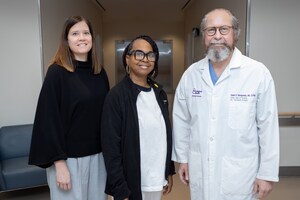NEW YORK, March 30, 2022 /PRNewswire/ -- NYU Langone Health is joining a new National Institutes of Health (NIH)-sponsored program called Accelerating Medicines Partnership Autoimmune and Immune-Mediated Diseases (AMP AIM) as a leading center to discover new targets for therapy in these diseases.
This new effort, which is supported by $58 million in public and private funding, is an expansion of the AMP program founded in 2014 which initially focused on understanding the cellular and molecular pathways of rheumatoid arthritis and systemic lupus erythematosus, and now is being expanded to include psoriatic disease and Sjögren's syndrome.
The partnership will pair rheumatologists, dermatologists, nephrologists, immunologists, and computational and systems biologists from NYU Langone and several other academic centers across the U.S. with the NIH, the U.S. Food and Drug Administration, pharmaceutical companies, and nonprofit organizations. Jill Buyon, MD, the Sir Deryck and Lady Va Maughan Professor of Rheumatology in the Department of Medicine, will serve as contact principal investigator of the AMP AIM program's lupus team. Jose U. Scher, MD, the Steere-Abramson Associate Professor of Medicine, will lead the program's microbiome core and serve as co-PI of a psoriatic disease clinical team, and Peter M. Izmirly, MD, associate professor of medicine, will oversee a clinical site for the Sjögren's syndrome team.
An Acceleration of Discoveries in Lupus Research
Dr. Buyon's group in the new AMP AIM program, the Lupus Omics Cutaneous Kidney Investigation Team (LOCKIT), is a partnership with Johns Hopkins University, The Ohio State University, and the University of Pennsylvania. This leadership team will also be bolstered by additional sites including Albert Einstein College of Medicine, University of California, San Francisco, Brigham and Women's Hospital, University of Michigan, University of Rochester, and University of Texas South Western. These institutions' established patient registries will be leveraged to address molecular underpins of early kidney disease, refractory lupus nephritis and a spectrum of cutaneous disease with the hope of bringing new therapies to patients.
"As the pace of discovery in the biology, genetics, and environmental regulation of systemic lupus erythematosus (SLE) accelerates, the speed and efficiency of translationally applying that research to clinical care assumes even greater importance," Dr. Buyon says. "We now have an unprecedented opportunity to harness technological advances to deconstruct and reconstruct the enormity of phenotypic and immunologic heterogeneity in this prototypic autoimmune disease."
NYU Langone's Division of Rheumatology led one of the lupus disease teams for the earlier AMP program that paved the way for the now-expanded effort. The SLE team's focus on lupus nephritis, aided by an enrollment of more than 150 patients at NYU Langone who contributed kidney tissue for research, helped establish that biopsies are safe. The team developed new protocols for tissue preservation and dissociation and set the stage for transcriptomic evaluation of single cells. This work has already identified new cell clusters and pathways that may lead to novel therapies and identified that accessible tissue such as the skin may hold clues to kidney disease
Probing the Microbiome and Skin for Clues
The AMP AIM program's microbiome core, or Micro-TeACH (Microbiome Technology and Analytic Center Hub), led by Dr. Scher, will incorporate intestinal, skin, and other tissue-related microbiome features to aid in the pathogenesis reconstruction for various autoimmune and immune mediated diseases. Micro-TeACH is a NYC-based hub and will expand a decade-long collaboration with the Clemente Lab at the Icahn School of Medicine at Mount Sinai.
The hub will help researchers interrogate the gut microbiome and its potential metabolic capacity to modulate anti-rheumatic drugs' pharmacokinetics and response to therapy. In addition, the tools will enable an integration of the cutaneous and oral microbiome with tissue-derived spatial transcriptomics and single-cell technologies to better understand the triggers of inflammation and autoimmunity.
The psoriatic disease team Dr. Scher is co-leading as well has been dubbed ELLIPSS, or ELucidating the Landscape of Immunoendotypes in Psoriatic Skin and Synovium and is a coalition led by of dermatologists, rheumatologists, immunologists and epidemiologists from U of Rochester, Univ. of Michigan, UCSF and UPenn. Participants in ELLIPSS with varying stages of psoriatic disease will undergo biopsies of the skin and joint synovium to better identify the distinct functional or pathobiological mechanisms.
"The skin may have the code for who progresses, why, and how," Dr. Scher says. "We want to find which cells that reside in the skin are being attracted—the term we use is homing—to the joints and produce and promote inflammation there."
Any patterns and pathways, in turn, could have major implications for therapeutics. "What's in that code may help us adopt a desperately needed precision medicine approach," Dr. Scher says.
Interrogating the Tissue and Systems Biology of Sjögren's Disease
The Sjögren's Team for Accelerating Medicines Partnership (STAMP), led by University of California, San Francisco, Dr.Caroline Shiboski, is strategically positioned to apply cutting-edge technologies to interrogate the tissue and systems biology of Sjögren's disease (SjD). Dr. Izmirly will join the team and recruit subjects from NYU Langone's large outpatient practice, with a focus on those with lupus and SjD overlap.
Sjögren's Disease (formerly known as Sjögren's syndrome) is a common systemic autoimmune rheumatic disorder second only to rheumatoid arthritis in prevalence. There are very few therapeutic options for patients outside of symptom management, so there is a need for better understanding of the pathogenetic mechanisms of disease. The STAMP group is positioned to further this goal, designing clinical research protocols to recruit, enroll, phenotype, and collect relevant biospecimens from, observational cohorts of individuals with SjD and controls.
"We have expertise in rheumatology, oral health, and ophthalmology, and will perform full recruitments of these subjects using the best practices established by the STAMP group," says Dr. Izmirly. "By standardizing these protocols, we will be in a position to better understand the pathogenesis of SjD and the mechanisms of the disease's progression, which will allow us to identify therapeutic targets and new biomarkers."
"The Division of Rheumatology has a proven record of excellence in research and clinical care," says Steven Abramson, MD, executive vice president and vice dean for education, faculty, and academic affairs at NYU Langone and chair of its Department of Medicine. "As leaders in this nation-wide endeavor, we now have an opportunity to bring our world-class researchers to the forefront of the fight against autoimmune and inflammatory diseases."
MEDIA INQUIRIES:
Ryan Dziuba
(212) 404-4131
CELL: (646) 581-8548
[email protected]
SOURCE NYU Langone Health

WANT YOUR COMPANY'S NEWS FEATURED ON PRNEWSWIRE.COM?
Newsrooms &
Influencers
Digital Media
Outlets
Journalists
Opted In





Share this article